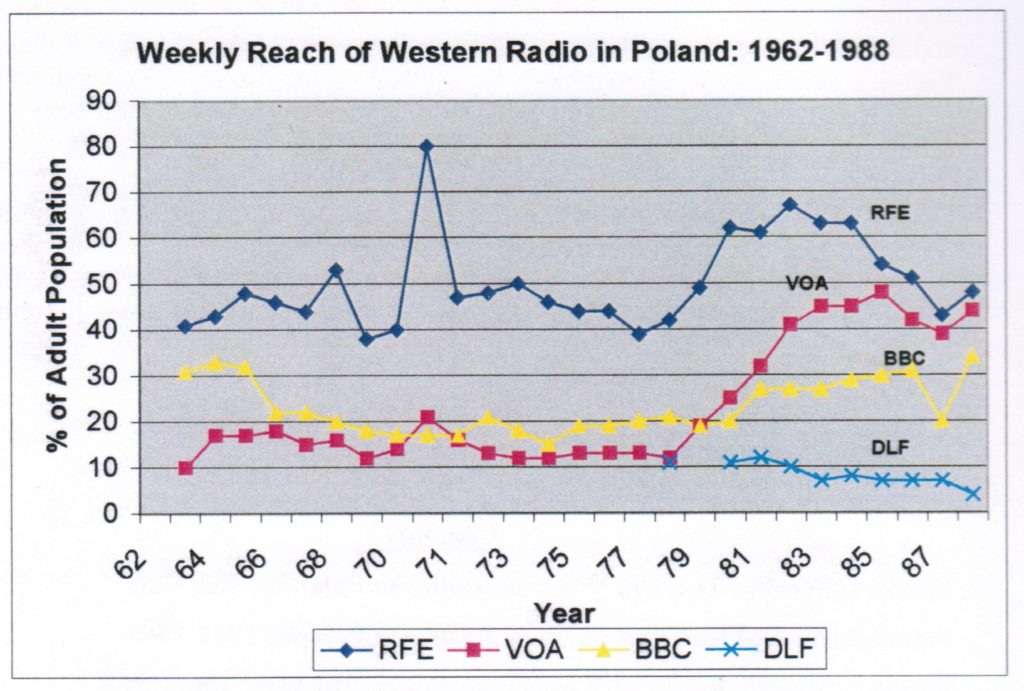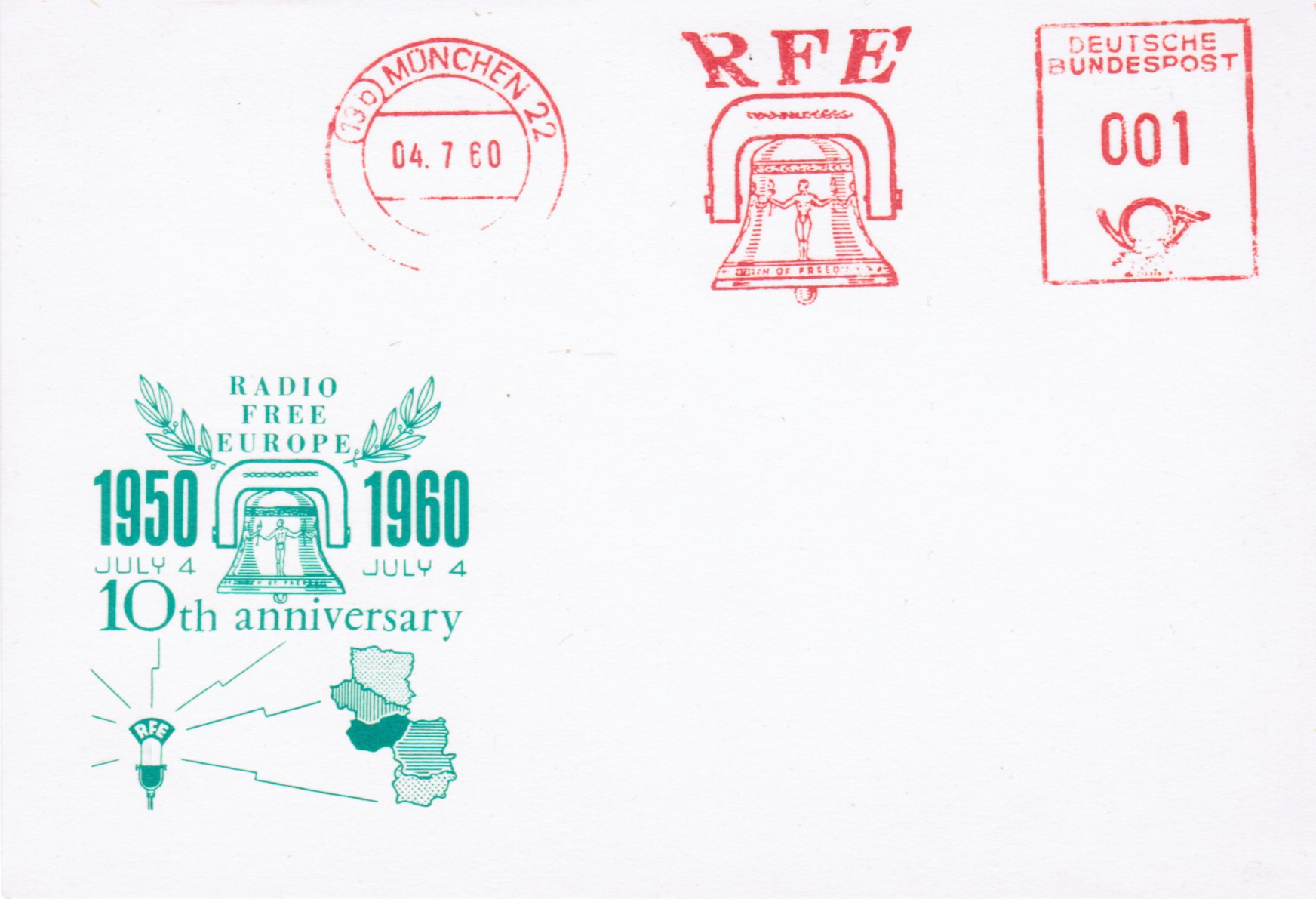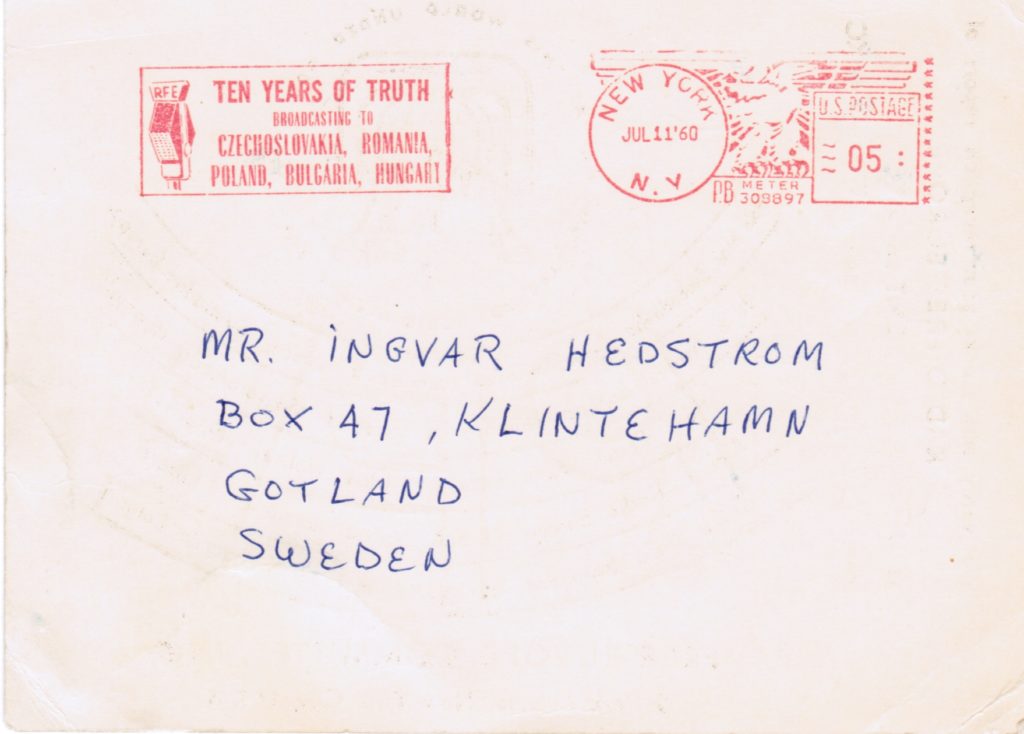By TED LIPIEN
As described by Sig Mickelson in his 1983 book America’s Other Voice: The Story of Radio Free Europe and Radio Liberty, Radio Free Europe began broadcasting behind the Iron Curtain on July 4, 1950.
On July 4, 1950, only 13 months after the founding of the Free Europe Committee and seven months after crating RFE, the new international broadcast station fed its first 30 minutes into Barbara’s electronic tubes and on through the antenna system to Czechoslovakia. The hastily organized Czechoslovak staff working in New York headquarters had produced a program consisting of news, information, and political analysis. In subsequent days, the rhombic antenna was reoriented so that it was possible to begin broadcasting to Romania on July 14, to Hungary and Poland on August 4, and to Bulgaria on August 11.1
First RFE broadcasts originated in New York in offices in the Empire State Building. “Barbara” was the name of a low-power, 7 and a half kilowatt shortwave transmitter at Lampertheim, a few kilometers north of Mannheim in West Germany. The radio’s headquarters were soon moved from New York to Munich in Bavaria.
Radio Liberty began broadcasting in Russian to the Soviet Union from a transmitter in Lampertheim on March 1, 1953.
Radio Free Europe and Radio Liberty were created to supplement the work of the Voice of America (VOA) established in 1942 as the more official U.S. government international broadcaster which was increasingly viewed in Washington as both ineffective and constrained in responding to propaganda from the Soviet Union and communist regimes loyal to and largely controlled by Moscow. VOA did not produce Russian-language programs until 1947 because U.S. officials in charge of VOA during World War II and immediately after the war did not want to offend Soviet dictator Josef Stalin and complicate U.S.-Soviet relations.
In 1951, Voice of America listeners in communist-ruled Poland, in letters smuggled to the United States still described VOA programs as “uninteresting, drab, bureaucratic in tone, unconvincing.” Excerpts from some of these letters were read on the floor of the House of Representatives on July 24, 1951 by Congressman Richard B. Wigglesworth (R-MA).2 The establishment of Radio Free Europe was the response of the U.S. government’s executive and legislative branches to what was generally regarded during the initial phases of the Cold War as VOA’s institutional inability to be an effective player in the propaganda war with the Soviet Union and international communism.
On its 10th anniversary in 1960, Radio Free Europe used radio transmitters located in Portugal, Spain and West Germany. Compared to the 7 and a half kilowatt transmitter used for the first broadcast to Czechoslovakia in 1950, RFE transmitters in 1960 were much more powerful in delivering the signal and overcoming some of the jamming by the East European communist regimes. The station was regarded as being highly successful in identifying and challenging Soviet propaganda with truthful news and commentary. By 1960, RFE had a massive following in East and Central Europe.

Sig Mickelson, who in his long journalistic career was the first president of the CBS News Division and its Chief Executive for News and Public Affairs, served as president of the Free Europe and the Radio Liberty Committees and later as president of Radio Free Europe/Radio Liberty, Inc. While the Free Europe and the Radio Liberty Committees were composed of private individuals who were raising private donations, Radio Free Europe and Radio Liberation (the name was changed later to Radio Liberty) were in fact secretly funded and to a degree guided and managed by the Central Intelligence Agency (CIA) until 1972. The CIA’s role ended in 1972 and the station’s funding was appropriated directly since then by the U.S. Congress.

Answer this call for help from behind the Iron Curtain!
GIVE THE GIFT OF FREE MEN AND WOMEN…GIVE THE TRUTH!
Send Your Truth Dollar for
RADIO FREE EUROPE
to: CRUSADE FOR FREEDOM
care of your local Postmaster
ADVERTISING COUNCIL PUBLIC SERVICE
This is one of many letters smuggled out from behind the Iron Curtain that prove the importance of RADIO FREE EUROPE in the battle for men’s minds.
The battle of Communist lies against the truth.
This is your battle too! Your own freedom is endangered, for if Communist lies stay unanswered, if the truth does not get through, the Reds will have won a decisive victory in their Cold War.
You can help by keeping the strong, crystal-clear voice of RADIO FREE EUROPE broadcasting the truth to combat communist lies!3
You must help! RADIO FREE EUROPE is a private organization that depends on your dollars to pay for equipment, announcers, and news analysts necessary to combat Communist lies!
The “Crusade for Freedom” ad campaigns in magazines and radio programs in the United States in the 1950s and 1960s to raise money for Radio Free Europe were somewhat deceptive because they failed to disclose that almost all of the radio station’s budget came from secret CIA appropriations requested by the various U.S. administrations and approved by the U.S. Congress. Nevertheless, the information in these ads about political repression behind the Iron Curtain was accurate and helped to educate Americans about the importance of Radio Free Europe’s and Radio Liberty’s mission.
A 1960 Crusade for Freedom ad placed in TIME magazine showed quotes from a letter sent by a Polish listener to Radio Free Europe programs. The letter writer urged Radio Free Europe “to keep broadcasting the truth,” stating that “Radio Free Europe gives us hope for a better future.”
During and after CIA’s involvement, journalists working for both Radio Free Europe and Radio Liberty in Munich, West Germany, in New York and at its other bureaus enjoyed a much greater degree of editorial independence than VOA broadcasters in Washington, DC. RFE’s language services were better funded and better staffed than foreign language services at the Voice of America, where much of the public funding was spent on English-language broadcasts, which had a minimal audiences outside of some countries in Africa, and on its large and constantly growing federal bureaucracy. Management reforms during the Reagan administration reversed this trend to some degree and led to internal transfers of some of the longtime VOA executives. These changes were bitterly resisted by former managers and some of the VOA English newsroom staff but were generally welcomed by most of the foreign language VOA personnel.
Mickelson correctly observed in his book that “Gradually, both Radios attained large and attentive audiences, generally larger than those of the Voice of America or the BBC.”4 Audience surveys conducted during the Cold War showed that the RFE Polish Service had a far larger following in Poland than either the Voice of America or the BBC.
In 1969, VOA’s weekly reach in Poland was slightly over 10% to RFE’s 50%. In 1971, RFE’s weekly listenership jumped to 80% during one of many workers’ strikes and anti-regime demonstrations in Poland; VOA’s audience increased to 20%. In the 1970s, RFE’s weekly reach in Poland was between 40% and 50%; VOA’s was between 10 and 20%.

Surveys were conducted for Radio Free Europe among travelers from Eastern Europe by independent market research firms in Western Europe.5

Satchmo, looks over some of his recordings with Willis Conover (left),
host of the Voice of America English Service program, “Music, U.S.A.”
As a teenager living in communist-ruled Poland in the 1960s, I listened mostly to RFE, sometimes to BBC, and rarely to VOA. Even RFE’s music programs for young listeners were better and much more popular than similar VOA music programs with the exception of Willis Conover’s jazz broadcasts for a slightly older group of listeners. Conover’s jazz programs were especially popular in the Soviet Union.6
VOA eventually caught up with RFE in Poland in the number of listeners despite still having fewer hours of broadcasting but not until management and programming reforms implemented during the Ronald Reagan administration allowed the Polish Service, of which I was in charge in the 1980s, to tell the whole truth about communism and the Soviet Union. It is true, however, that in the Soviet Union, the Voice of America had at times during the Cold War a larger audience than Radio Liberty, according to surveys. The same was true to some degree in Czechoslovakia: VOA had a slightly larger number of listeners than RFE but only after 1984, according to surveys.
In other countries of Eastern Europe–Hungary, Romania and Bulgaria–RFE was much more popular, as it was in Poland, where RFE had a dominant position in terms of listenership and impact for most of the Cold War. RFE had more broadcasting hours to these countries, but its programs were also more heavily jammed by the communist regimes than VOA broadcasts.
RFE broadcasts were considerably different than VOA broadcasts at least until the 1980s. During World War II, the Voice of America spread Soviet propaganda lies about the Katyn massacre of thousands of Polish military officers who had been secretly executed by the Soviet NKVD secret police in 1940. Both Soviet and VOA propagandists falsely blamed the genocide on the Germans. 7
Many of VOA’s broadcasters during the war, when U.S. government overseas radio broadcasting was managed by the Office of War Information (OWI), were pro-Soviet fellow travelers. VOA’s chief news writer in 1942-1943 was American communist author Howard Fast who in 1953 received the Stalin International Peace Prize worth about $235,000 in today’s dollars.8 He remained in charge of VOA news until the end of 1943 and later worked as a reporter for the Communist Party USA newspaper The Daily Worker.9 Some of the other World War II VOA broadcasters were foreign communists who later switched sides and worked as propagandists for the Soviet-controlled regimes in Eastern Europe.10 It took VOA about the decade to shake off its early legacy of collusion with Soviet propagandists–a historical fact hidden and never acknowledged by the VOA leadership in later years.
From 1945 until about 1952, VOA was still largely silent about Soviet crimes. VOA did not start to hire anti-communist journalists until the late 1940s. One of them was Zofia Korbońska, the legendary anti-Nazi fighter, World War II secret radio operator and a brief prisoner of the Soviet NKVD. Together with her husband, Polish agrarian party politician Stefan Korboński, she escaped to the West in 1947. She died in Washington, D.C. in 2010.11
Under pressure from the U.S. Congress, VOA lifted its censorship of the Katyn story in the early 1950s, but partial censorship in favor of the Kremlin to promote the policy of detente returned in later years. VOA was most free to discuss Soviet and communist crimes in the 1980s. It was then that it had the largest audience in Poland.
But as former director of Radio Free Europe Polish Service (1952-1976) Jan Nowak-Jeziorański told Polish journalist and film director Beata Postnikoff in a 1992 interview for a documentary film about the Voice of America, RFE and VOA played different but complementary and much needed roles.
There was no real competition between us although our Voice of America colleagues were jealous of our much larger resources, 24-hour broadcasts, and above all our editorial independence. The Voice of America is after all part of the U.S. government apparatus while we were as an organization not only very autonomous but the Polish Service staff also had practically full independence and initiative. We had the right to speak as Poles to other Poles from our point of view, while the Voice of America is in a way a projection of the United States. Perhaps this is not necessarily restricted to presenting only the [U.S.] government point of view, but Poland in those [VOA] broadcasts is to be presented only in the general, American context. This includes for example the role and the activities of the Polish-American community, because it is part of the American picture. In my opinion, both radios had their special characteristics. In each case different ones, which complemented each other.
When I was asked by Americans whether in light of great success which Radio Free Europe had achieved in Poland, there is still any need for the Voice of America, I always answered–absolutely yes–because [VOA] is our shield from using us as an instrument of the U.S. government on a daily basis. As long as the Voice of America exists, we are left alone. If the Voice of America ceased to exist, we would then find ourselves under great pressure from [U.S.] government institutions to present their point of view.
It can be said that the U.S. government did not interfere [with RFE] on a daily basis, but I must say that there are such constant tendencies and the Voice of America is very much oppressed by the government service and government bureaucracy…But despite of this, I say VOA is doing a good job.
Jan Nowak Jeziorański died in Poland in 2005.
A Wikipedia article on History of Poland (1945-1989) described how communism came to an end in Poland:
The striking electoral victory of Solidarity candidates in the 1989 limited elections, and the subsequent formation of the first non-communist government in the region in decades, encouraged many similar peaceful transitions from communist party rule in Central and Eastern Europe in the second half of 1989.[
In December 1989, changes to the Polish constitution were made, officially eliminating the “socialist” order: Marxist references were removed and the name of the country was changed back to the Polish Republic.
The last post-Soviet troops left Poland in September 1993.
Ted Lipien is a former director of VOA Polish Service in the 1980s and former VOA acting associate director in 2006.
NOTES:
- Sig Mickelson, America’s Other Voice: The Story of Radio Free Europe and Radio Liberty (New York: Praeger, 1983), 30.
- Cold War Radio Museum, “Voice of America 1951 – ‘Drab’ ‘Unconvincing’,” February 24, 2018, https://www.coldwarradiomuseum.com/2018/02/23/voice-of-america-1951-drab-and-unconvincing-rep.-wiggleswoth-quotes-listeners-in-poland/.
- Crusade for Freedom, Radio Free Europe ad, TIME, February 29, 1960, 93
- Sig Mickelson, America’s Other Voice: The Story of Radio Free Europe and Radio Liberty (New York: Praeger, 1983), vii.
- R. Eugene Parta, (Former) Director of Audience Research and Program Evaluation, Radio Free Europe/Radio Liberty, Inc., “Listening to Western Radio Stations in Poland, Hungary, Czechoslovakia, Romania and Bulgaria: 1962-1988 — Longitudinal Listening Trend Charts.” Prepared for the Conference on Cold War broadcasting Impact co-organized by the Cold War International History Project Woodrow Wilson International Center for Scholars, Washington, DC and the Hoover Institution of Stanford University, Stanford, California, October 13-15, 2004.
- Cold War Radio Museum, “Willis Conover Interviewing Louis Armstrong for VOA Program Music, U.S.A.,” June 30, 2018, https://www.coldwarradiomuseum.com/willis-conover-interviewing-louis-armstrong-for-voa-program-music-usa/.
- Cold War Radio Museum, “OWI head Elmer Davis spreads Soviet Katyn propaganda lie in Voice of America broadcasts,” May 11, 2018, https://www.coldwarradiomuseum.com/owi-head-elmer-davis-promotes-soviet-katyn-propaganda-lie-in-the-u.s.-and-in-voice-of-america-radio-broadcasts/.
- Howard Fast, Being Red (Boston: Houghton Mifflin Company, 1990), 18-19.
- Ted Lipien, “Stalin Prize-Winning Chief Writer of Voice of America News,” Cold War Radio Museum, March 12, 2019, https://www.coldwarradiomuseum.com/stalin-prize-winning-former-chief-writer-of-voice-of-america-news/.
- Ted Lipien, “Stefan Arski: Agent of Communist Collusion at VOA,” Cold War Radio Museum, April 14, 2018.
- Ted Lipien, LIPIEN: Remembering a Polish-American patriot, The Washington Times, September 1, 2010. http://www.washingtontimes.com/news/2010/sep/1/remembering-a-polish-american-patriot/.













